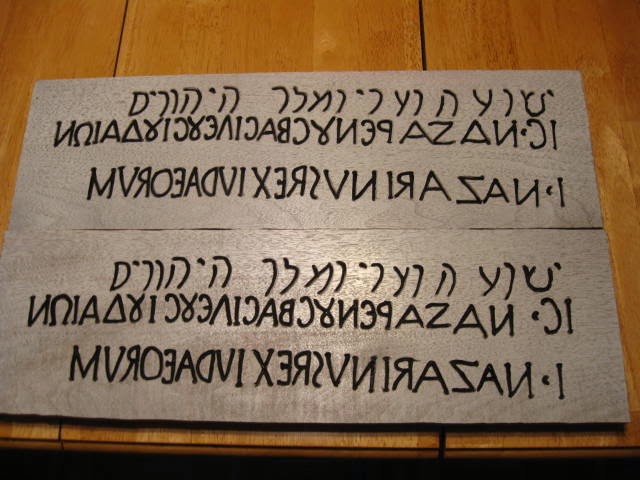The 'Titulus Crucis' is the inscription placed on the Cross of Jesus in Hebrew, Greek and Latin saying Jesus of Nazareth King of the Jews. It has caused some controversy in that the paleographic evidence would date it to the 1st-4th century but it was carbon dated to the 10th century. Also it has the Greek and Latin running in reverse from right to left like the Hebrew. Other historical evidence seems to say that the original 'titulus crucis' was divided in two. The Greek and Latin on one piece was taken to Rome and the Hebrew on a second remained in Jerusalem.
Wikipedia states: "... In 1997, the German author and historian Michael Hesemann performed investigation of the relic. Hesemann presented the inscription of the title to seven experts on Hebrew, Greek and Latin palaeography: Dr. Gabriel Barkay of the Israel Antiquity Authority, Prof. Dr. Hanan Eshel, Prof. Dr. Ester Eshel and Dr. Leah Di Segni of the Hebrew University Jerusalem, Prof. Dr. Israel Roll and Prof. Dr. Ben Isaac of the University of Tel Aviv and Prof. Carsten Peter Thiede of Paderborn/Germany and the University of Beer Sheva, Israel. According to Hesemann, none of the consulted experts found any indication of a mediaeval or late antique forgery. They all dated it in the timeframe between the 1st and the 3-4thcentury AD, with a majority of experts preferring and none of them excluding the 1st century. Hesemann concluded that it is very well possible that the Titulus Crucis is indeed the authentic relic...".
I believe the solution is very obvious. The titulus crucis venerated today is not the original titulus crucis but a faithful copy done in Carolingian times. The inscriber had access to faithful tracings of the two divided parts of the original titulus crucis. However when he made a faithful copy he reversed the tracing of the Greek and Latin while the Hebrew one he didn't. The inscriber obviously wasn't literate in any of the three languages but just copied faithfully what he saw on to the piece of almond wood.
Of course I could be wrong as carbon dating is notoriously unreliable and it could be the original and the inscriber was a Jew who knew the Hebrew but was copying the Greek and Latin from a written text and inscribing it in the direction he as a Hebrew writer was used to.
What is very interesting is that the Hebrew phrase was written in a way that it revealed the Divine Name YHVH. Yeshua Hanazareti V'melech Hayehudim is Jesus the Nazarene and King of the Jews. INRI is the abbreviation of the Latin and INBI of the Greek. This would explain why the High Priest wanted the inscription changed as it was a common Jewish practice to hide authorship or a message in a Hebrew phrase by reading the first Hebrew letter. The late Rav Kaduri did this with his famous letter revealing the name of the Messiah as Yehoshua by the Hebrew phrase Yarim Ha’Am Veyokhiakh Shedvaro Vetorato Omdim meaning "He will lift the people and prove that his word and law are valid".
.

